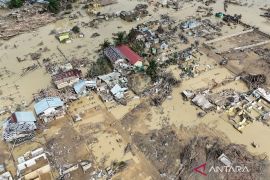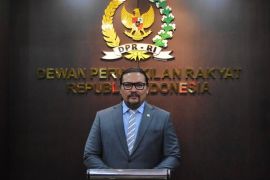"Do not be too loud or else the birds will fly away," one of the students stated.
The weather was still overcast despite the rain having stopped. Since 6 a.m., Zulfikar Niode, the coordinator, and his friends had been preparing to observe the lake birds though heavy rain had hindered their efforts.
The students, dressed in inconspicuous colors, were divided into three groups, each equipped with a binocular and book to facilitate their identification of bird species.
Each group is guided by an expert, with experience as a birdwatcher and wildlife photographer.
A few minutes later, they trained their binoculars at a bird whose chest was dark blue while it was black from head to its back. They witnessed that its beak and legs were red, and the bird, a Purple swamphen, or Phorpyrio porphyrio, excitingly played among the expanse of water hyacinths.
Purple swamphens are commonly found in Lake Limboto. This type of waterbird is often targeted by hunters visiting the lake on weekends.
"Watching birds turned out to be exciting. The challenge was when we were identifying what kind and observing the characteristics of the bird that has flown," one of the participants revealed.
This bird-watching activity was the first time for her group, but they have always been involved in actions and campaigns that fight for the good of the environment.
Related news: 179 bird species facing extinction in Indonesia: conservation agency
Census of waterbirds
Observation and counting of the number of birds in Lake Limboto is a census activity of water birds initiated by three organizations: Gorontalo Biodiversity (BIOTA), Gorontalo Society of Indonesian Environmental Journalists (SIEJ), and the Alliance of Independent Journalists (AJI) of Gorontalo City.
For SIEJ and AJI, the activity aimed to enrich the journalists' knowledge in writing about environmental issues, especially the biodiversity of waterbirds and wetland habitats, considering that environmental issues have not been a priority issue of journalists and mass media in Gorontalo.
BIOTA secretary Rosyid Azhar affirmed that the waterbird census in Lake Limboto is part of the 2022 Asian Waterbird Census (AWC) also held in other regions and countries.
Lake Limboto was selected as one of the census locations, as the area is a habitat for over a hundred bird species recorded by BIOTA over the past six years.
According to Azhar, Lake Limboto has experienced quite complex problems in the form of siltation and shrinkage, among others, that still continue to occur.
"For today's bird census, we recorded that there are 21 species, 10 of which are waterbirds. I expected more birds to be observed, but we started the observations around afternoon, though ideally, in the morning and evening, when the bird starts to eat or return to the nest, "Azhar revealed.
The recorded species of waterbirds are black bittern (Ixobrychus flavicollis), Javan pond heron (Ardeola speciosa), purple heron (Ardea purpurea), cattle egret (Bubulcus ibis), and little egret (Egretta garzetta).
The other species are wandering whistling duck (Dendrocygna arcuata), white-browed crake (Amaurornis cinerea), whiskered tern (Chlidonias hybrida), and purple swamphen (Phorphyrio phorphyrio).
"We also recorded other non-waterbird species, such as black kite (Milvus migrans), savanna nightjar (Caprimulgus affinis), and lesser coucal (Centropus bengalensis). Not all birds near the waters are water birds. What is meant by waterbirds is the one whose life depends on wetlands," Azhar explained.
Related news: Papua's four endemic birds released into natural habitat: BKSDA
All can participate
Waterbirds are more commonly found in natural and human-made wetland habitats, including rivers, lakes, ponds, beaches, mangroves, peat swamps, rice paddies, sewage and garbage dumps, as well as several other locations.
AWC Indonesia acting coordinator Ragil Satriyo Gumilang noted that the AWC is part of the International Waterbird Census (IWC) working through a voluntary network.
According to Gumilang, the AWC conducted in Indonesia aimed to support the most recent data on the species, population, and important habitats of waterbirds.
The goal of this activity was also to increase public capacity and awareness about the important value of water birds and wetlands in Indonesia.
The status of 871 species of water birds was studied scientifically to determine ways to manage them.
In Indonesia, the wildlife population data is useful for formulating the management of several national parks, determining important locations for the Ramsar Convention and the East Asian–Australasian Flyway Partnership, and the status of protected wildlife species.
Since 1986, Wetlands International Indonesia has monitored the implementation of AWC programs across Indonesia.
In 2022, AWC Indonesia's "citizen science," a form of public participation in the efforts of advancing updated data, was held along with the Ministry of Environment and Forestry, Wetlands International Indonesia, Indonesian Wildlife Ecology Foundation (EKSAI), BirdLife Indonesia Association, and Burungnesia.
This census is held once a year simultaneously. In 2022, AWC in Indonesia was held during the January-February period.
The types of birds whose data was collected comprised egrets, herons, ducks, chickens, cormorant, oriental darters, pelicans, gulls, crakes, and other waterbirds.
"Anyone can participate, be it a professional birdwatcher, an amateur bird observer, a nature lover, or one who never observed a bird," Gumilang stated.
2021 census results
Gumilang reported some changes from the AWC Indonesia data, wherein the number of participants had dropped by 29 percent in 2021 on account of the COVID-19 pandemic.
In contrast, the number of observation sites increased by 70 percent, from 124 locations in 2020 to 211 locations in 2021, with the most number of locations being in Java, followed by Sumatra, Kalimantan, Bali / Nusa Tenggara, Maluku, Sulawesi, and Papua.
Gumilang affirmed that the number of participants had increased as a result of the ease of data reporting mechanisms through the Burungnesia app.
In 2021’s census, 77,436 birds were reported and verified, in which 81 percent were waterbirds, 16 percent were non-aquatic birds, and three percent were unidentified.
In terms of the diversity of species, it was reported that there were 272 species of birds, including 105 species of waterbirds, of which 55 percent were classified as protected, and the other 167 were non-waterbirds.
Among those reported birds were five types that are endangered, based on the IUCN Red List: great knot (Calidris tenuirostris), storm's stork (Ciconia stormi), milky stork (Mycteria cinerea), Far Eastern curlew (Numenius madagascariensis), and Nordmann's greenshank (Tringa guttifer).
Two reported waterbirds -- Chinese egret (Egretta eulophotes) and the lesser adjutant (Leptoptilos javanicus) -- fell into the vulnerable category.
Disparity in data still exists among observation sites across Indonesia, as more than 50 percent of the data came from Java, while central and eastern Indonesia has fewer reports.
For instance, some 32 percent of the waterbird species had been recorded in Indonesia but were not reported in the AWC Indonesia activities in the last five to six years.
However, on the positive side, the lack of updated data reminds of the importance of up-to-date data realization to offer certainty in mitigating the decline in wildlife populations.
Related news: NTT returns 23 rare birds to Maluku for release to their habitat
Related news: Creating a paradise for cenderawasih in Warkesi
Translator: Debby H, Kenzu T
Editor: Sri Haryati
Copyright © ANTARA 2022












